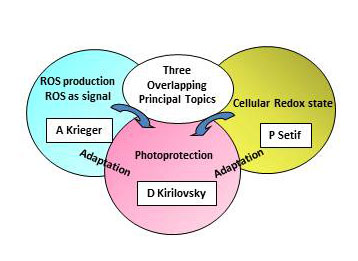However, light becomes dangerous when the energy arriving at the reaction centers of the photosynthetic apparatus exceeds the energy consumption by multiple cellular processes. In this case, the photosynthetic electron transport chain becomes reduced and reactive oxygen species (ROS) leading to severe damage of the cells are accumulated, especially at the level of the photosynthetic apparatus. This occurs at high light intensities but nutrient starvation and low CO2 conditions will provoke this disequilibrium at lower irradiance. Thus, in our oxygen-rich atmosphere photosynthetic organisms are especially exposed to oxidative stress.

Plants, algae and cyanobacteria have developed mechanisms that rapidly respond to these different stresses using the existent enzymatic and photosynthetic machinery but also have developed long-term acclimation responses that involve protein synthesis and degradation to maintain the balance between the energy absorbed and the energy used, to decrease the formation of ROS or to scavenge them. Despite the fact that light and ROS in excess are a source of stress, they have also a major role in cellular signaling and regulation of gene expression in acclimation processes. The cellular redox metabolism, including the redox state of the photosynthetic and respiratory electron transport chains, is also an essential regulator of protein synthesis and degradation.
Our studies are also important for biotechnological applications since plants and cyanobacteria are the centre of several bioenergy programs. Antennae size, ROS production and photoprotective mechanisms affect differently the production of biomass, biofuel or bio-hydrogen in plants and cyanobacteria. Our studies could help to find the better strains and conditions for biofuel and biomass production.
Three major subjects are studied in our research sub-group :
Photoprotection in cyanobacteria (D Kirilovsky);
Oxidative stress and ROS signalling (A Krieger-Liszkay)
Cellular redox state and its influence in regulation mechanisms (P Setif).